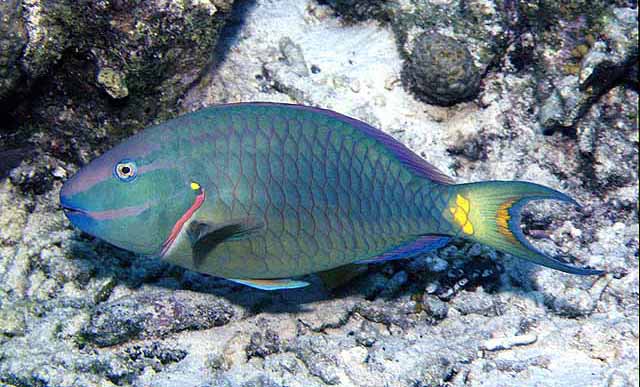| Scaridae (Parrotfishes), subfamily: Sparisomatinae |
| 64 cm TL (male/unsexed); max.weight: 1,600.0 g |
|
reef-associated; marine; depth range 3 - 50 m |
| Western Atlantic: southern Florida (USA), Bermuda, Bahamas, and throughout the Caribbean Sea to Brazil. |
|
Dorsal spines (total): 9-9; Dorsal soft rays (total): 10-10; Anal spines: 3-3; Anal soft rays: 9-9. Relationship between fork length (FL) and maximum body depth (D): D = 0.10 + 0.33(FL); FL = -0.40 + 3.06(D), for n = 79, length range (cm, FL) = 13.5-25.5 (Ref. 3191). A distinctive, colorful and abundant fish. Young adults and females with scales outlined in darker gray; often bright red below. Super males green, with bright yellow spot at upper edge of gill cover, yellow bar at base of tail, curved orange-yellow mark on caudal fin rays (Ref. 26938). Initial phase fish with a brown head, the scales of the upper two-thirds of the body with pale centers and dark brown edges, the lower third of body and fins bright red. Terminal phase males are green with three diagonal orange bands on upper half of head |
| Inhabits coral reefs with clear water (Ref. 13628). Young may be found in seagrass beds and other heavily vegetated bottoms. Feeds mainly on soft algae, but has been observed to graze on live corals like, Montastraea annularis (Ref. 6496). Produces a significant amount of sediment through bioerosion using its strong beak-like jaws and constantly re-growing teeth (Ref. 6485). Protogynous; strictly diurnal, spends the night sleeping on the bottom (Ref. 5221). Found singly or small in small groups. |
|
Least Concern (LC); Date assessed: 15 September 2009 Ref. (130435)
|
| reports of ciguatera poisoning |
Source and more info: www.fishbase.org. For personal, classroom, and other internal use only. Not for publication.
